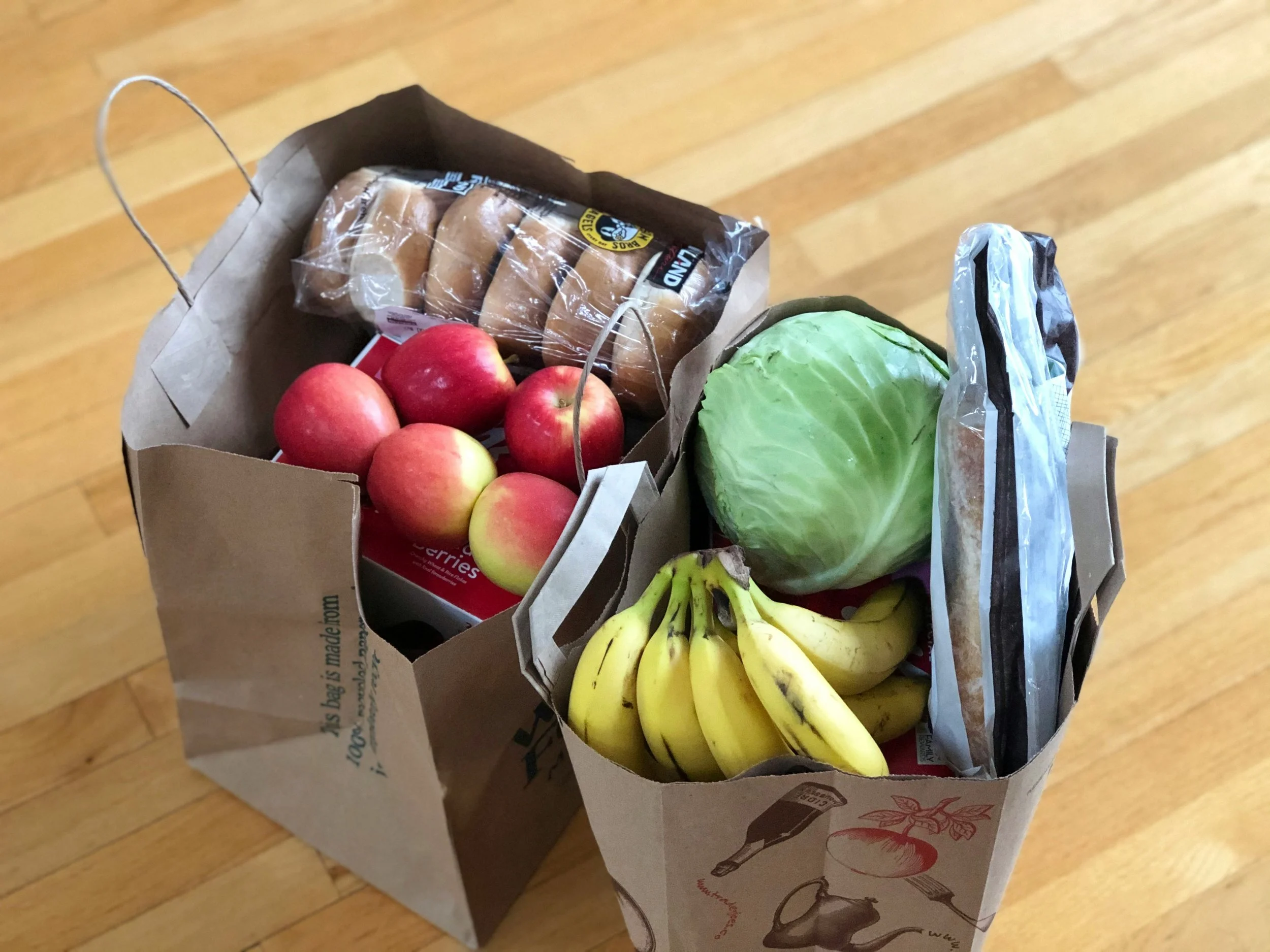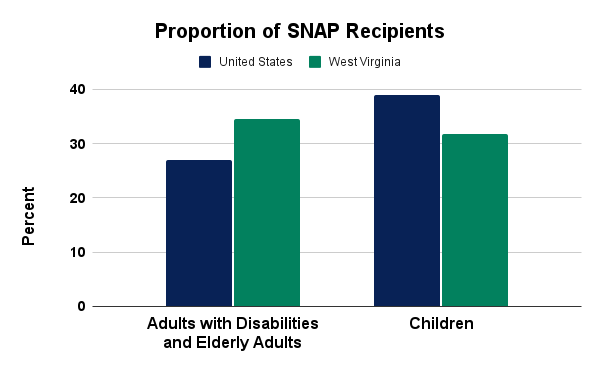
West Virginia SNAP
The Supplemental Nutrition Assistance Program (SNAP) assists individuals in purchasing food, including about 14% of West Virginians. New federal law and the October 2025 federal government shutdown brought various changes to SNAP. This Science and Technology Note explores SNAP’s function, its changes, and how states are navigating SNAP amidst the federal shutdown.
Research Highlights
SNAP is a federally-funded program that helps low-income individuals afford food.
14.4% of West Virginians are eligible for SNAP.
New federal law will affect SNAP in West Virginia by increasing work hour requirements for eligibility, limiting the use of benefits, and requiring increased financial contributions from the State.
Some states, including West Virginia, are navigating the federal lapse in SNAP funding by increasing funding to state food banks in order to pre-emptively alleviate expected issues to food access.
SNAP in West Virginia
SNAP (formerly Food Stamps) is a US Department of Agriculture (USDA) program offering food and nutrition assistance to low-income individuals. In order to provide assistance, the USDA makes payments to states, which are then charged with distributing benefits to qualifying applicants. Individuals qualify through their state, and basic eligibility and benefits depend on income and household expenses.
About 1 in every 6 adults and 1 in every 5 children faces hunger in West Virginia. Of all recipients, adults with disabilities and elderly adults make up a higher proportion of SNAP recipients and children make up a lower proportion in West Virginia than the US. In order to be eligible for SNAP in West Virginia, a household’s net income must be below the federal poverty level ($2679/month for a 4 person household). In fiscal year (FY) 2022, the most recent data available, 14.4% of West Virginians were SNAP-eligible compared to 11.6% nationally.
Based on USDA state data and SNAP Action Dashboard.
Qualifying individuals receive their benefits through an Electronic Benefits Transfer (EBT) card, similar to a debit card. Generally, lower income and increased household members correlate to increased benefits. These benefits can be used to purchase things such as: produce, meat, fish, poultry, dairy products, bread, cereal, snacks, beverages, and plants to grow food. SNAP benefits are not allowed to be used to purchase items such as: alcohol, tobacco, pet food, cleaning supplies, toilet paper, tobacco, or vitamins.
Data was obtained from the USDA’s SNAP State Activity Reports.
The West Virginia Department of Human Services’ Bureau for Family Assistance administers SNAP benefits in West Virginia. The actual benefits per person depend on household income and deductions. The average monthly benefit per person from FY 2018-2023 increased in West Virginia from $139 to $200. Similarly, regular federal SNAP funding to West Virginia increased between FY 2018-2023. Emergency allotments for SNAP between FY 2020-2023 peaked in 2021 and 2022, likely due to the COVID-19 pandemic, and this funding was ended in FY 2023.
Federal funding for West Virginia SNAP 2018-2024, not including administrative costs. Regular funding (green) indicates funding that West Virginia would normally receive from the USDA. Emergency allotment (blue) is additional funding due the pandemic, which ended in 2023. Based on data obtained from the USDA’s SNAP State Activity Reports and Annual Data.
SNAP can also provide economic benefits. By participating in SNAP, students receive direct certification for free school meals, decreasing hurdles to participation in school nutrition programs. Studies indicate that every $1 paid in SNAP benefits generates $1.54-$1.79 in economic activity by directly supporting food retailers and jobs in the community. This is further bolstered by SNAP Employment and Training, which helps SNAP participants gain workforce training and access services to gain employment.
2025 Federal SNAP Changes
West Virginia SNAP will be impacted due to the recent passage of HR 1 in Congress. New eligibility requirements mandate that recipients comply with work requirements, which require all non-pregnant able-bodied persons aged 18-64 to work or volunteer at least 80 hours/month. Beginning October 1, 2025, funding for SNAP-Education (SNAP-Ed), which provides education on how to best utilize SNAP benefits, cook healthy meals, and lead an active lifestyle, ended. West Virginia was allocated $4.1 million for SNAP-Ed in 2024 and may continue this program until all of the funds have been used.
The change that could most significantly affect West Virginia financially is the adjustment of administrative cost sharing and payment error rates. Currently, West Virginia is responsible for 50% of SNAP administrative cost fees, which will rise to 75% in October 2026. Additionally, beginning October 2027, states will be required to contribute a portion of SNAP benefits based on their payment error rate (PER), which must be below 6% to avoid state SNAP contributions. Payment errors are largely unintentional and may be due to incorrect income reporting by an applicant or incorrect calculation of household expenses by a state agency. West Virginia had a PER of 9.43% in FY 2024, which will require a 10% share of SNAP costs. In total, estimates suggest that with these changes, West Virginia will pay $85 million for SNAP in FY 2028, compared to $18 million in FY 2023.
State Responses to the Shutdown
There have been worries surrounding SNAP funding due to the October 2025 federal government shutdown and various responses by states. The USDA announced that SNAP benefits will not be paid out in November and contingency funds are not available to cover the lapse in funding. This has been met with critics arguing that this is contradictory Congressional funding allocations and the USDA’s own September 2025 Lapse of Funding Plan, which states that SNAP funding would not stop.
On October 28, 2025, a lawsuit was introduced representing 22 state attorneys general, Washington DC’s attorney general, and 3 governors suing the USDA to reinstate SNAP funding during the shutdown. West Virginia could seek to join this lawsuit, but should consider possible ramifications from the Administration from doing so.
As of October 28, 2025, multiple states have requested or approved state allocations for food banks (Minnesota, California, Colorado, New Mexico, and New Hampshire) or to continue funding SNAP benefits (New York, Louisiana, Virginia, and Hawaii). Governor Morrisey expedited distribution of $1.1 million in funds allocated to be distributed to food banks throughout the year and announced up to $13 million of pre-appropriated emergency funding for food banks. He has also activated the National Guard to assist food distribution logistics. Additionally, West Virginia could seek to fully fund SNAP during the shutdown similarly to other states, though this would likely cost over $47 million per month (based on FY 2024 funding) and the USDA has said they will not reimburse states for November SNAP funding.
This Science and Technology Note was prepared by Nathan G. Burns, PhD, West Virginia Science & Technology Policy Fellow on behalf of the West Virginia Science and Technology Policy (WV STeP) Initiative. The WV STeP Initiative provides nonpartisan research and information to members of the West Virginia Legislature. This Note is intended for informational purposes only and does not indicate support or opposition to a particular bill or policy approach. Please contact info@wvstep.org for more information.




